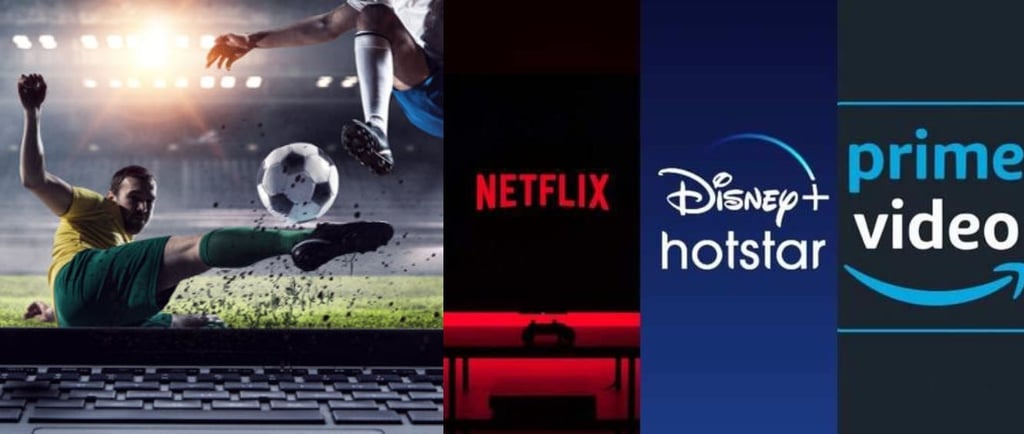The Streaming Wars in European Football
As technology evolves and the way we consume sports changes, the broadcasting industry is undergoing a major shake-up. This blog explores how streaming platforms are challenging traditional TV networks in European football.
Kyriakos Lykourgos
4/17/20255 min read


Introduction: Sports Broadcasting in the Streaming Era
The digital disruption which has been reshaping the U.S. sports viewing landscape has now made its way to Europe. American tech giants have secured exclusive rights and are battling for media dominance on the European sports stage. Live sports events are one of the only forms of media left that have the power to bring massive audiences to tune in in real time, so subscription services and streaming platforms have started competing with traditional TV networks to make sports a key part of their product offerings.
Big tech over-the-top (OTT) platforms began prioritising consumer data ownership, platform scalability, and shifting focus away from legacy broadcast deals as a way to diversify their revenue models. This model has been tested for a long time in the U.S., and it seems to be beneficial for both sports organisations and broadcasters. For example, Apple secured a 10-year deal with Major League Soccer (MLS) for $2.5 billion, and Amazon landed the rights for Thursday Night Football.
Why Are Tech Giants Racing to Control European Sports Broadcasting
Owning the broadcasting rights of sports events has much more to offer the distributor than just content control. It is essential for these companies because it allows them to collect data, gain global reach, and drive advertising revenue. Tech giants like Apple and Amazon understand the value of owning the overall customer experience, not just the air time. They care more about real-time engagement, data collection, and creating user ecosystems.
Moreover, these companies are also subscription-based. It's beneficial for them to make the consumer spend more time on their product and become more dependent on it. This way they can boost subscription prices and also drive engagement through targeted ads (which they do much more efficiently than traditional broadcast channels).
The Current State of Sports Broadcasting
Europe is already going through a transition. Major football leagues across the continent are switching their broadcasting partners. Even though the change took longer than it did in the U.S., due to factors like regulatory barriers, diverse market conditions, and cultural attachments, the shift is clearly happening.
Examples of tech platforms entering the market include Italy, where DAZN and Sky Italia made a deal worth €4.5 billion over five seasons. In France, Amazon Prime Video acquired the rights to stream Ligue 1 matches, and even non-subscribers can access matches via a pay-per-view model at around €3 per game. In Germany, the Bundesliga splits its broadcasting rights between DAZN and traditional broadcasters. The Premier League, on the other hand, is still in contract with Sky Sports and BT Sport, with that deal expiring at the end of the 2025 season.
The same trend is appearing in other sports too. For example, EuroLeague Basketball has a deal with FanDuel, which ensures that one game from each regular season round airs exclusively on FanDuel channels and their OTT platform.
Additionally, some sports leagues and clubs are exploring direct-to-consumer models, launching their own streaming platforms or negotiating shorter, more flexible broadcasting deals. This gives them more control over distribution and fan engagement, while also increasing their share of media revenue.
Consumer Behaviour and Platform Value
The modern-day sport consumer varies significantly from the traditional sports fan of the past decades. The consumers now increasingly favour watching sports content across multiple devices, such as their mobile phones, tablets, laptops and smart TVs. This new-age consumer behaviour enhances the reach and time spent by a consumer on sports content.
This shift is also being driven by changing consumer viewing habits. Younger audiences, particularly those aged 18–34, are turning away from traditional TV in favour of streaming platforms and social media. This demographic is now consuming sports content through a mix of platforms, including YouTube, Instagram, and dedicated OTT apps like Amazon Prime Video and DAZN. Traditional TV, on the other hand, remains popular among older viewers, especially those 55 and over, who are more likely to rely on cable and satellite channels for sports broadcasts.
Monetisation and Platform Strategy
Moreover, companies like Apple and Amazon value sports broadcasting rights beyond traditional advertising revenues. This is a key difference these OTT platforms have from regular broadcasters. Some of these platforms sell and produce their own products and services. By integrating sports fans into their ecosystems, they can directly market the products they offer, such as iPhones, Alexa devices, Prime memberships and more. Because of this, they also stop relying solely on third-party ad revenue.
On the other hand, OTT platforms also have an advantage over traditional broadcasting channels because they can generate significantly more advertising income through personalised marketing. A traditional broadcasting channel sells 30-second ad slots at a fixed rate. OTT platforms can leverage user data to serve multiple targeted ads tailored to individual viewers. In this way, they increase effectiveness by showing each consumer highly relevant products, and they can also generate more advertising momey because they are not limited to a single advertisement slot shown to everyone.
The shift toward personalised, cross-device experiences puts pressure on traditional broadcasters, who are now trying to catch up by digitising their services and investing in interactive, mobile-friendly platforms.
Traditional Broadcasters vs OTT Platforms
As OTT platforms expand in Europe, traditional broadcasters are actively adapting. Sky Sports has enhanced its digital offerings by introducing the Sky Go app, allowing subscribers to watch live TV, on-demand content, and download shows for offline viewing on mobile devices, tablets, and laptops at no extra cost. This app provides access to Sky's channels, including free-to-air options like ITV and Channel 4, aiming to meet the growing demand for flexible viewing.
In collaboration with OTT platforms, broadcasters are exploring ways to reach wider audiences. For instance, Sky partnered with DAZN in Italy to distribute broadcasting rights, combining traditional and digital media strengths.
However, OTT platforms face challenges in the European market. Amazon Prime Video, for example, has emphasised the importance of localisation in its global expansion strategy, tailoring content to local tastes and languages to better serve diverse European audiences. Additionally, varying internet infrastructure across Europe poses limitations. In some regions, especially rural areas, internet speeds may not support seamless streaming, affecting the quality of OTT services.
To keep up with the demands of modern audiences, both traditional broadcasters and OTT platforms are getting creative in engaging viewers. Broadcasters like Sky Sports have introduced interactive features through apps like Sky Go, offering subscribers more control over their viewing experience. OTT platforms, meanwhile, are using consumer data to provide personalised content recommendations and even integrating social media to keep fans connected. Platforms like Amazon Prime Video are experimenting with live social interactions, letting viewers chat with each other and share content in real-time during games. These innovative strategies are helping to capture the attention of younger, tech-savvy audiences who demand more than just a passive viewing experience.
The Future of Sports Broadcasting in Europe
The future of sports broadcasting in Europe is being shaped by the growing influence of OTT platforms like Amazon Prime and Apple TV, which are transforming how fans engage with live sports. With exclusive deals like Amazon’s Thursday Night Football and Apple’s MLS partnership, these tech giants are moving past traditional broadcasting and offer more personalised, on-demand ways to watch sport.
Traditional broadcasters like Sky Sports and BT Sport are adapting by enhancing digital offerings, like Sky Go and partnering with OTT services to expand their reach. The trend towards streaming is undeniable, with more leagues and clubs exploring direct-to-consumer models to better control content and revenue. Lastly, in the coming years, the media landscape will likely be a combination of traditional and OTT models. Their success will depend on securing valuable rights and creating immersive, data-driven experiences that keep fans engaged and the sponsors satisfied.
